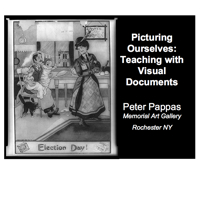I recently worked with educators from across the Rochester NY area in a workshop titled “Picturing Ourselves: Teaching with Visual Documents” at a workshop held at the Memorial Art Gallery.
We looked at strategies for using visual document to create student-centered lessons that invite students to construct their own meaning. Our focus included – the relevance of essential questions, higher order thinking skills, and linking visual literacy with listening and reading skills. Presentation Notes (4 mb) pdf.
Most importantly, we considered choosing images that contain information that is not overly dependant on background knowledge. This enables students of all ability level to successfully “do the work of the historian.”
Use this guide (9 kb) pdf to compare these two images (446 kb) pdf. The first is a famous photo of the linking of the transcontinental railroad. Without background knowledge, students merely see a group of men standing around two trains. Contrast with the second photo from the Stone Collection of a 1910 street scene in Rochester NY. Without much background knowledge students see autos, bicycles, electric trolleys, horse-draw wagons and pedestrians. Independently they can use this image to construct their own understanding of the changes in transportation in the early 20th century.
“Homefront America” is a lesson designed to improve content reading comprehension with an engaging array of source documents – including journals, maps, photos, posters, cartoons, historic data and artifacts. I developed it to serve as a model for blending essential questions, higher order thinking and visual interpretation.
For more ideas go to my websites Teaching with Documents and Content Reading Strategies that Work For more images from the Stone Collection of the Rochester Museum and Science Center as well as images of Rochester and New York State try The Rochester Image Project. The Library of Congress Prints and Photographs Collection can be searched here.


